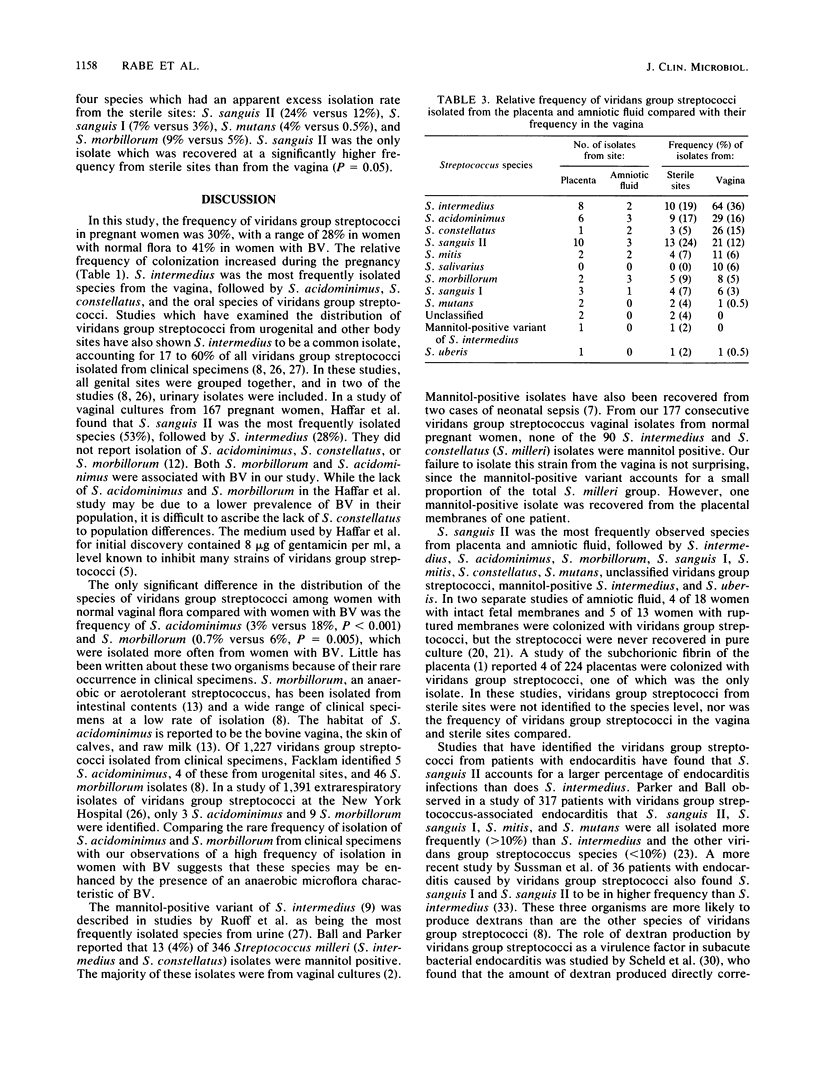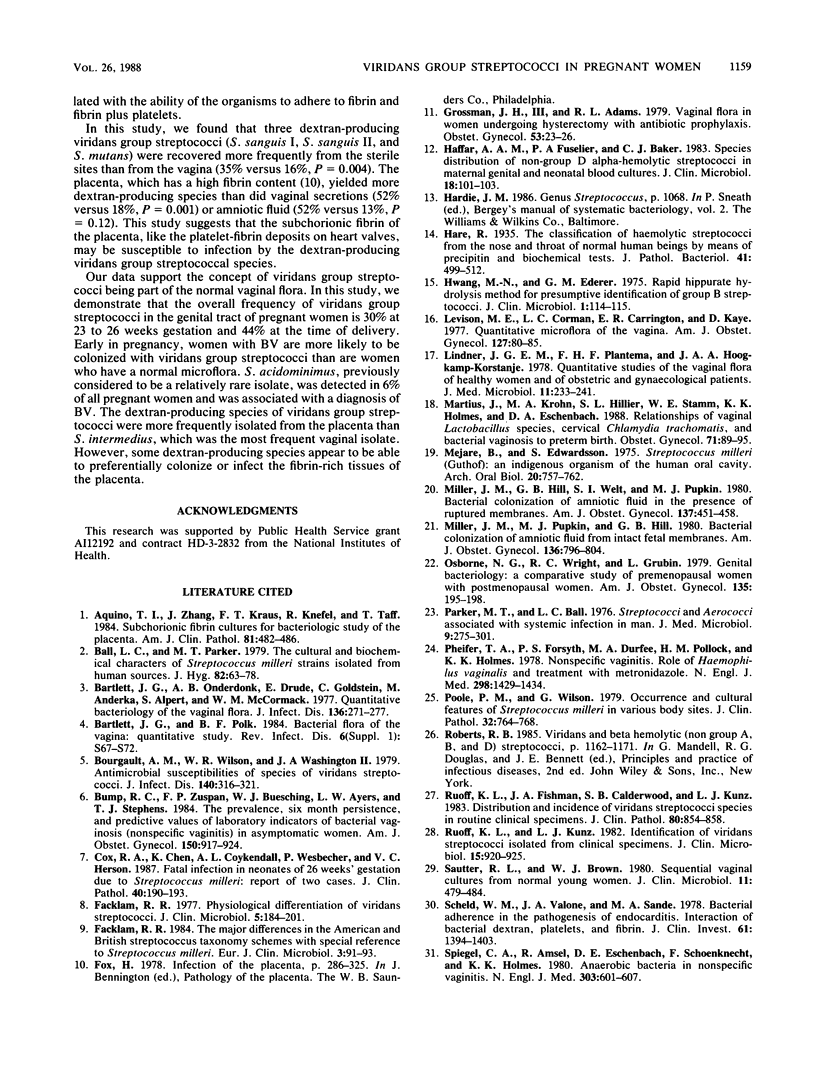Abstract
The prevalence and role of viridans group streptococci in the female genital tract have not been well described. In this study of 482 pregnant women, 147 (30%) were culture positive for viridans group streptococci. Of 392 women with predominant Lactobacillus morphotypes by Gram stain (normal), 110 (28%) were colonized with viridans group streptococci, compared with 37 (41%) of 90 women with bacterial vaginosis (BV) (P = 0.02). To determine whether any species were associated with BV, 177 consecutively isolated viridans group streptococci from the vagina were identified to the species level by using the Facklam scheme. The most frequently isolated species from the vagina was Streptococcus intermedius (13%), followed by Streptococcus acidominimus (6%), Streptococcus constellatus (5%), Streptococcus sanguis II (4%), Streptococcus mitis (2%), Streptococcus salivarius (2%), Streptococcus morbillorum (2%), Streptococcus sanguis I (1%), Streptococcus mutans (0.2%), and Streptococcus uberis (0.2%) with an average of 1.2 species per woman. The distribution of the species among women with BV compared with normal women was not significantly different, with the exception of two species which were associated with BV: S. acidominimus (18% versus 3%, P less than 0.001) and S. morbillorum (6% versus 0.7%, P = 0.005). Amniotic fluid and placenta cultures yielded 54 isolates: S. sanguis II (13 isolates), S. acidominimus (9 isolates), S. intermedius (10 isolates), S. constellatus (3 isolates), S. mitis (4 isolates), S. sanguis I (4 isolates), S. morbillorum (5 isolates), S. mutans (2 isolates), S. uberis (1 isolate), mannitol-positive S. intermedius (1 isolate), and 2 isolates which were not classified. The distribution of species isolated from the upper genital tract was not a reflection of the distribution in the lower genital tract. Dextran-producing species of viridans group streptococci may have a greater pathogenic potential in the placenta than the non-dextran-producing species.
Full text
PDF




Selected References
These references are in PubMed. This may not be the complete list of references from this article.
- Aquino T. I., Zhang J., Kraus F. T., Knefel R., Taff T. Subchorionic fibrin cultures for bacteriologic study of the placenta. Am J Clin Pathol. 1984 Apr;81(4):482–486. doi: 10.1093/ajcp/81.4.482. [DOI] [PubMed] [Google Scholar]
- Ball L. C., Parker M. T. The cultural and biochemical characters of Streptococcus milleri strains isolated from human sources. J Hyg (Lond) 1979 Feb;82(1):63–78. doi: 10.1017/s002217240002547x. [DOI] [PMC free article] [PubMed] [Google Scholar]
- Bartlett J. G., Onderdonk A. B., Drude E., Goldstein C., Anderka M., Alpert S., McCormack W. M. Quantitative bacteriology of the vaginal flora. J Infect Dis. 1977 Aug;136(2):271–277. doi: 10.1093/infdis/136.2.271. [DOI] [PubMed] [Google Scholar]
- Bartlett J. G., Polk B. F. Bacterial flora of the vagina: quantitative study. Rev Infect Dis. 1984 Mar-Apr;6 (Suppl 1):S67–S72. doi: 10.1093/clinids/6.supplement_1.s67. [DOI] [PubMed] [Google Scholar]
- Bourgault A. M., Wilson W. R., Washington J. A., 2nd Antimicrobial susceptibilities of species of viridans streptococci. J Infect Dis. 1979 Sep;140(3):316–321. doi: 10.1093/infdis/140.3.316. [DOI] [PubMed] [Google Scholar]
- Bump R. C., Zuspan F. P., Buesching W. J., 3rd, Ayers L. W., Stephens T. J. The prevalence, six-month persistence, and predictive values of laboratory indicators of bacterial vaginosis (nonspecific vaginitis) in asymptomatic women. Am J Obstet Gynecol. 1984 Dec 15;150(8):917–924. doi: 10.1016/0002-9378(84)90381-8. [DOI] [PubMed] [Google Scholar]
- Cox R. A., Chen K., Coykendall A. L., Wesbecher P., Herson V. C. Fatal infection in neonates of 26 weeks' gestation due to Streptococcus milleri: report of two cases. J Clin Pathol. 1987 Feb;40(2):190–193. doi: 10.1136/jcp.40.2.190. [DOI] [PMC free article] [PubMed] [Google Scholar]
- Facklam R. R. Physiological differentiation of viridans streptococci. J Clin Microbiol. 1977 Feb;5(2):184–201. doi: 10.1128/jcm.5.2.184-201.1977. [DOI] [PMC free article] [PubMed] [Google Scholar]
- Grossman J. H., 3rd, Adams R. L. Vaginal flora in women undergoing hysterectomy with antibiotic prophylaxis. Obstet Gynecol. 1979 Jan;53(1):23–26. [PubMed] [Google Scholar]
- Haffar A. A., Fuselier P. A., Baker C. J. Species distribution of non-group D alpha-hemolytic streptococci in maternal genital and neonatal blood cultures. J Clin Microbiol. 1983 Jul;18(1):101–103. doi: 10.1128/jcm.18.1.101-103.1983. [DOI] [PMC free article] [PubMed] [Google Scholar]
- Hwang M. N., Ederer G. M. Rapid hippurate hydrolysis method for presumptive identification of group B streptococci. J Clin Microbiol. 1975 Jan;1(1):114–115. doi: 10.1128/jcm.1.1.114-115.1975. [DOI] [PMC free article] [PubMed] [Google Scholar]
- Levison M. E., Corman L. C., Carrington E. R., Kaye D. Quantitative microflora of the vagina. Am J Obstet Gynecol. 1977 Jan 1;127(1):80–85. doi: 10.1016/0002-9378(77)90318-0. [DOI] [PubMed] [Google Scholar]
- Lindner J. G., Plantema F. H., Hoogkamp-Korstanje J. A. Quantitative studies of the vaginal flora of healthy women and of obstetric and gynaecological patients. J Med Microbiol. 1978 Aug;11(3):233–241. doi: 10.1099/00222615-11-3-233. [DOI] [PubMed] [Google Scholar]
- Martius J., Krohn M. A., Hillier S. L., Stamm W. E., Holmes K. K., Eschenbach D. A. Relationships of vaginal Lactobacillus species, cervical Chlamydia trachomatis, and bacterial vaginosis to preterm birth. Obstet Gynecol. 1988 Jan;71(1):89–95. [PubMed] [Google Scholar]
- Mejàre B., Edwardsson S. Streptococcus milleri (Guthof); an indigenous organism of the human oral cavity. Arch Oral Biol. 1975 Nov;20(11):757–762. doi: 10.1016/0003-9969(75)90048-5. [DOI] [PubMed] [Google Scholar]
- Miller J. M., Jr, Hill G. B., Welt S. I., Pupkin M. J. Bacterial colonization of amniotic fluid in the presence of ruptured membranes. Am J Obstet Gynecol. 1980 Jun 15;137(4):451–458. doi: 10.1016/0002-9378(80)91126-6. [DOI] [PubMed] [Google Scholar]
- Miller J. M., Jr, Pupkin M. J., Hill G. B. Bacterial colonization of amniotic fluid from intact fetal membranes. Am J Obstet Gynecol. 1980 Mar 15;136(6):796–804. doi: 10.1016/0002-9378(80)90458-5. [DOI] [PubMed] [Google Scholar]
- Osborne N. G., Wright R. C., Grubin L. Genital bacteriology: a comparative study of premenopausal women with postmenopausal women. Am J Obstet Gynecol. 1979 Sep 15;135(2):195–198. doi: 10.1016/0002-9378(79)90342-9. [DOI] [PubMed] [Google Scholar]
- Parker M. T., Ball L. C. Streptococci and aerococci associated with systemic infection in man. J Med Microbiol. 1976 Aug;9(3):275–302. doi: 10.1099/00222615-9-3-275. [DOI] [PubMed] [Google Scholar]
- Pheifer T. A., Forsyth P. S., Durfee M. A., Pollock H. M., Holmes K. K. Nonspecific vaginitis: role of Haemophilus vaginalis and treatment with metronidazole. N Engl J Med. 1978 Jun 29;298(26):1429–1434. doi: 10.1056/NEJM197806292982601. [DOI] [PubMed] [Google Scholar]
- Poole P. M., Wilson G. Occurrence and cultural features of Streptococcus milleri in various body sites. J Clin Pathol. 1979 Aug;32(8):764–768. doi: 10.1136/jcp.32.8.764. [DOI] [PMC free article] [PubMed] [Google Scholar]
- Ruoff K. L., Fishman J. A., Calderwood S. B., Kunz L. J. Distribution and incidence of viridans streptococcal species in routine clinical specimens. Am J Clin Pathol. 1983 Dec;80(6):854–858. doi: 10.1093/ajcp/80.6.854. [DOI] [PubMed] [Google Scholar]
- Ruoff K. L., Kunz L. J. Identification of viridans streptococci isolated from clinical specimens. J Clin Microbiol. 1982 May;15(5):920–925. doi: 10.1128/jcm.15.5.920-925.1982. [DOI] [PMC free article] [PubMed] [Google Scholar]
- Sautter R. L., Brown W. J. Sequential vaginal cultures from normal young women. J Clin Microbiol. 1980 May;11(5):479–484. doi: 10.1128/jcm.11.5.479-484.1980. [DOI] [PMC free article] [PubMed] [Google Scholar]
- Scheld W. M., Valone J. A., Sande M. A. Bacterial adherence in the pathogenesis of endocarditis. Interaction of bacterial dextran, platelets, and fibrin. J Clin Invest. 1978 May;61(5):1394–1404. doi: 10.1172/JCI109057. [DOI] [PMC free article] [PubMed] [Google Scholar]
- Spiegel C. A., Amsel R., Eschenbach D., Schoenknecht F., Holmes K. K. Anaerobic bacteria in nonspecific vaginitis. N Engl J Med. 1980 Sep 11;303(11):601–607. doi: 10.1056/NEJM198009113031102. [DOI] [PubMed] [Google Scholar]
- Spiegel C. A., Amsel R., Holmes K. K. Diagnosis of bacterial vaginosis by direct gram stain of vaginal fluid. J Clin Microbiol. 1983 Jul;18(1):170–177. doi: 10.1128/jcm.18.1.170-177.1983. [DOI] [PMC free article] [PubMed] [Google Scholar]
- Sussman J. I., Baron E. J., Tenenbaum M. J., Kaplan M. H., Greenspan J., Facklam R. R., Tyburski M. B., Goldman M. A., Kanzer B. F., Pizzarello R. A. Viridans streptococcal endocarditis: clinical, microbiological, and echocardiographic correlations. J Infect Dis. 1986 Oct;154(4):597–603. doi: 10.1093/infdis/154.4.597. [DOI] [PubMed] [Google Scholar]
- Svensson L., Ingemarsson I., Mårdh P. A. Chorioamnionitis and the isolation of microorganisms from the placenta. Obstet Gynecol. 1986 Mar;67(3):403–409. [PubMed] [Google Scholar]
- Tashjian J. H., Coulam C. B., Washington J. A., 2nd Vaginal flora in asymptomatic women. Mayo Clin Proc. 1976 Sep;51(9):557–561. [PubMed] [Google Scholar]
- Taylor E., Blackwell A. L., Barlow D., Phillips I. Gardnerella vaginalis, anaerobes, and vaginal discharge. Lancet. 1982 Jun 19;1(8286):1376–1379. doi: 10.1016/s0140-6736(82)92498-9. [DOI] [PubMed] [Google Scholar]
- Wahbeh C. J., Hill G. B., Eden R. D., Gall S. A. Intra-amniotic bacterial colonization in premature labor. Am J Obstet Gynecol. 1984 Mar 15;148(6):739–743. doi: 10.1016/0002-9378(84)90558-1. [DOI] [PubMed] [Google Scholar]


